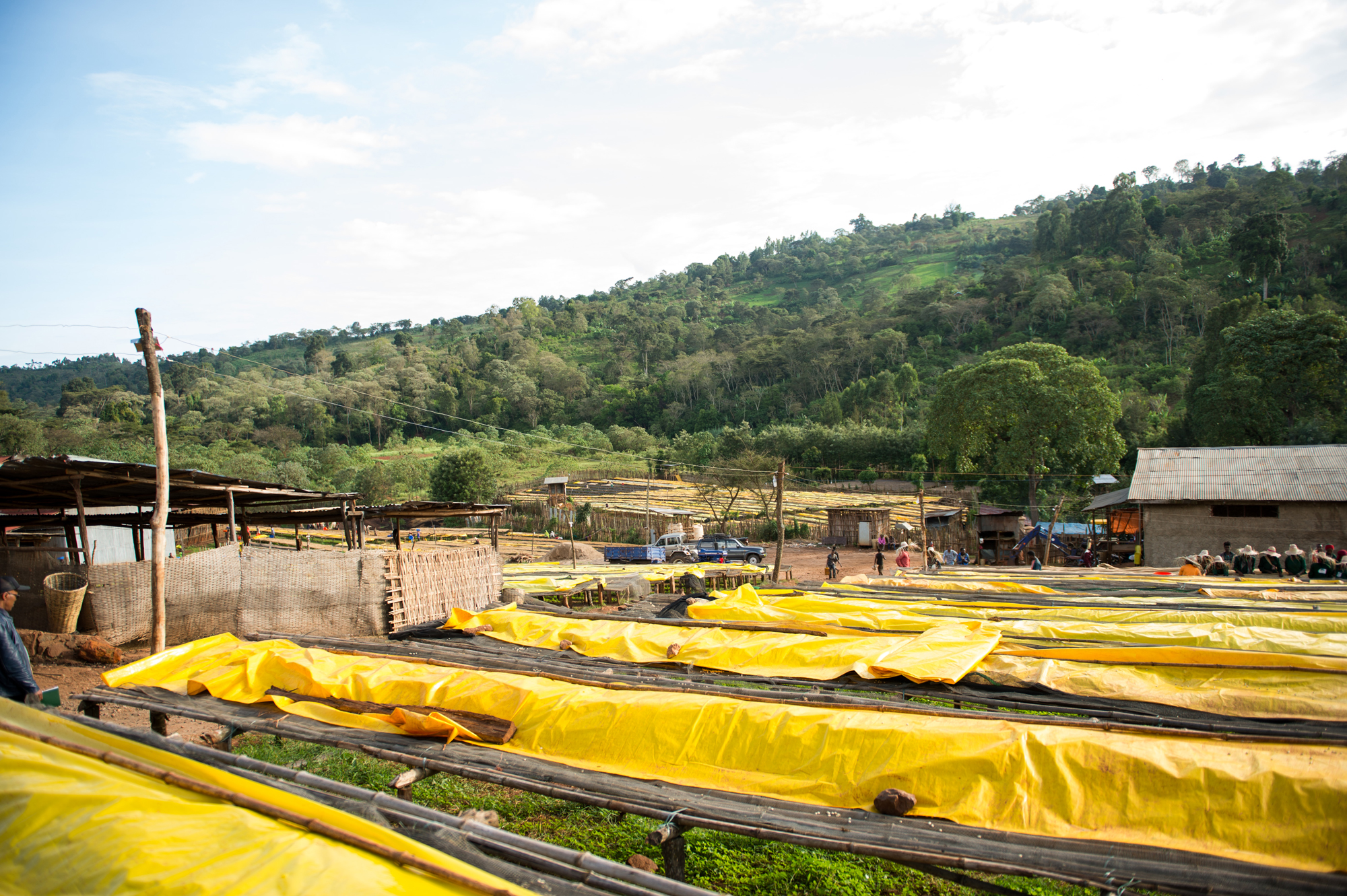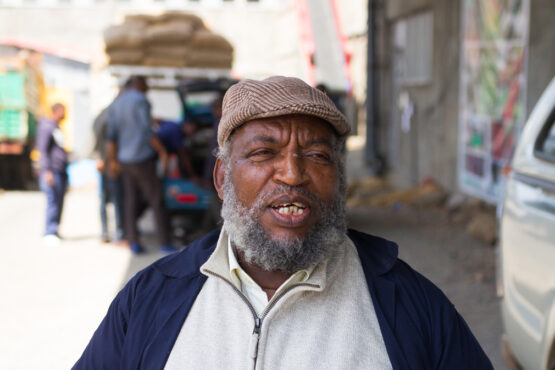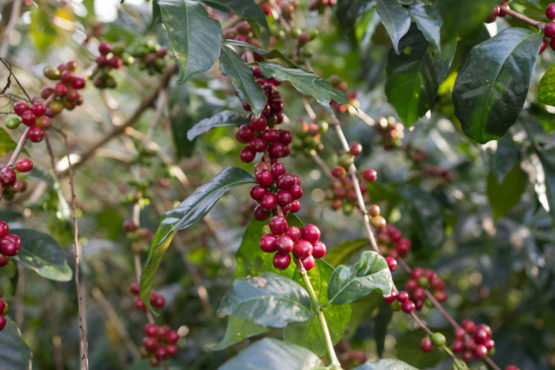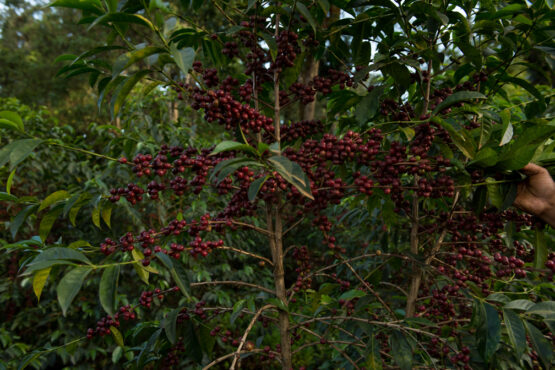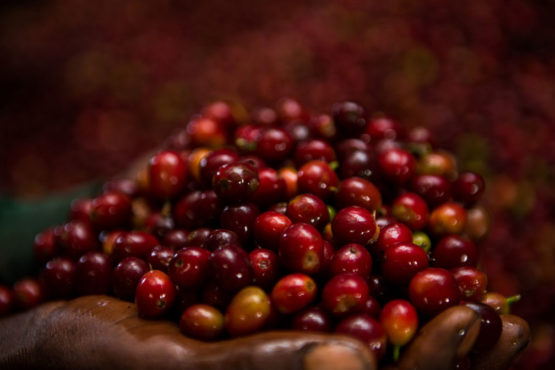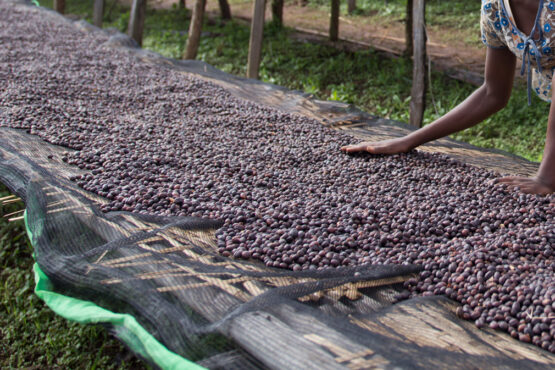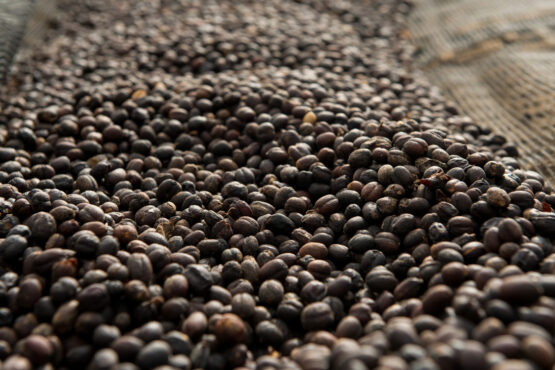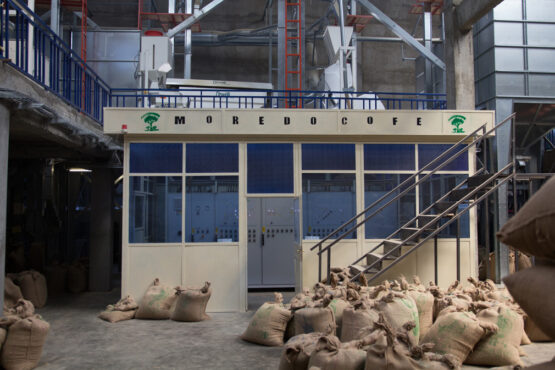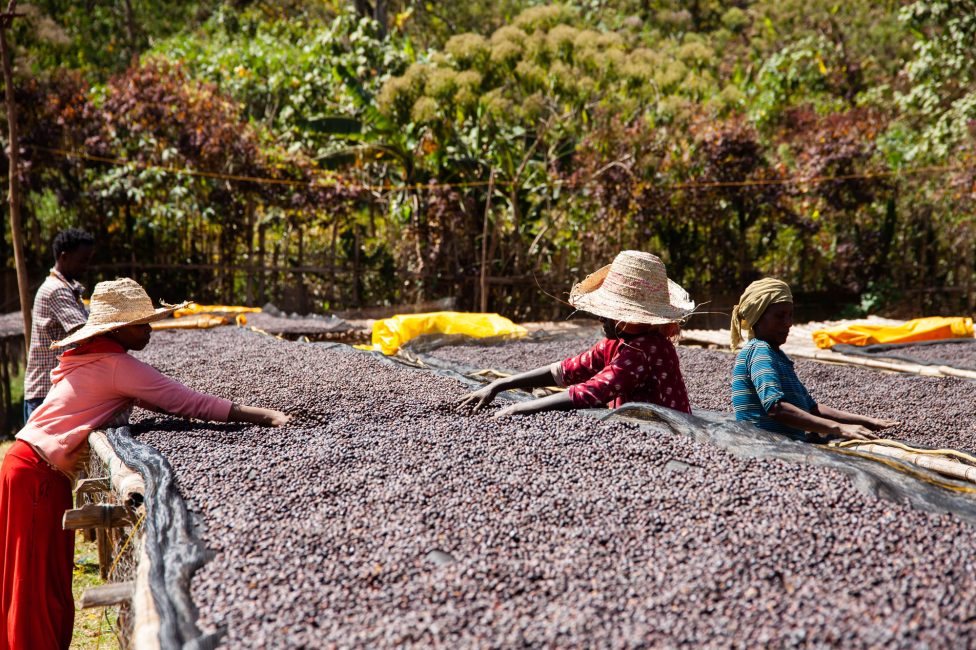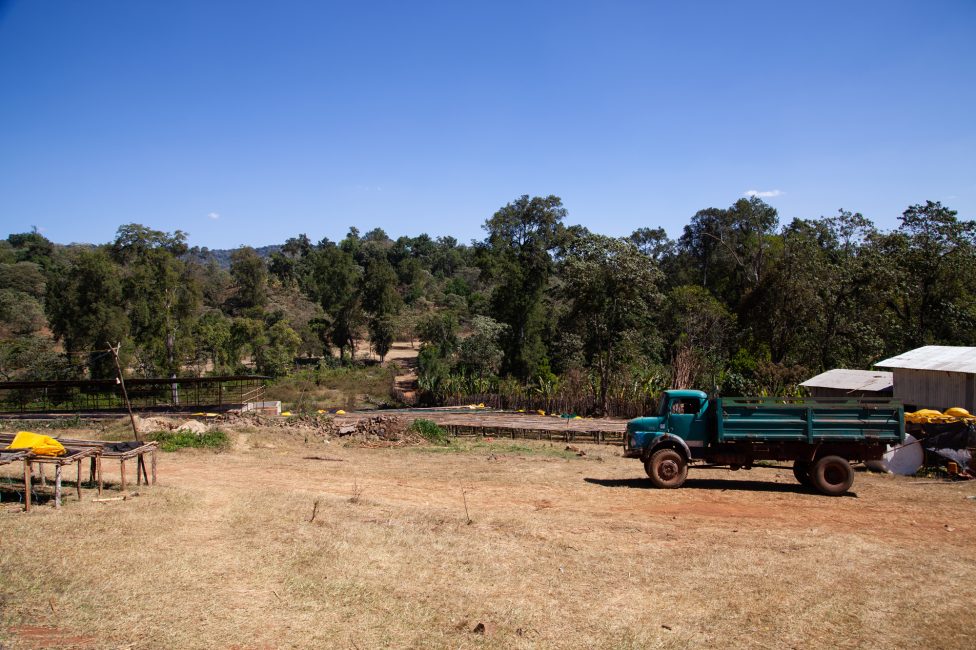Moredocofe Natural
Fruit forward, with bright tropical acidity and a rich and creamy mouthfeel. Guava, custard apple and crème brûlée.
Moredocofe (pronounced “Moor’d-coff”) is located in the Shakisso ‘woreda’ (administrative district) in the Guji zone in Ethiopia’s Southern Oromia State, about 200 miles from the Kenyan border.
Moredocofe stands for ‘Mora Mora River Valley Development Organic Coffee’ and was founded in 2002 by Haile Gebre and his wife Dimbelal Endale. They own two farms and a washing station under the Moredocofe umbrella, and also work with 300 smallholders (or ‘out-growers’ as they are commonly referred to in Ethiopia) to produce high quality, organic coffee.
Moredocofe is run by Haile Gebre and his family. In total they own around 500 hectares of land in Shakiso—which is very unusual in Ethiopia—and have planted 420 hectares with semi-forest coffee. Haile is passionate about many things and cares deeply about the environment; to this end he has dedicated 70 hectares to pure forest, and taken a very careful and considered approach to farming coffee.
In addition to their farm, Moredocofe is also dedicated to working with small producers to produce exceptional quality coffee, and to face the challenges of a delicate ecosystem, poor farming education, and limited access to quality and sustainability initiatives by addressing these issues front on.
Haile is passionate about development and growth on many levels. He believes very enthusiastically that his success can only come from the success of his local community in Shakiso, his out-growers, and his customers. He has many social programs in place to help develop his local community. For example, he has a nursery for propagating coffee seedlings, and he has made this large enough to share coffee seedlings with all of his out-growers free of charge. He sees this as an incentive for his local community to continue to plant and rejuvenate their coffee plantations, and also an incentive for them to grow. Haile has also provided the farming community with extensive education on cherry selection, harvesting, and best agricultural practices. He has a sample roaster and gives producers the opportunity to cup their coffees and better understand the feedback around taste.
Haile has also helped build a primary school for his local community, providing care and education to the children of his out-grower partners.
Haile is also passionate about organic farming and believes that this is the only truly sustainable way to produce coffee. One of his core beliefs is that what you take out of the earth—like fruit from the trees—you should put back into the earth in equal measure. To achieve this Haile has a program to compost organic material, including the pulp from coffee cherries, and encourages his out-grower partners to follow this program also.
ABOUT THE GUJI REGION
The Guji zone was established as a unique production area in 2002. It is located in the Southern portion of Sidama and is named after the Oromo people: a tribe with a long, proud history in coffee production.
Coffees from Guji were previously classified as ‘Sidama’ (a very wide geographical classification encompassing much of central-south Ethiopia), however more recently they have been separated from this classification and recognised for their unique and distinctive cup profiles. This distinctiveness is driven by the unique combination of elements in this production area, including high altitudes, rich, fertile soil, and exceptional heirloom varieties.
Guji is bordered on the south and west by Borena, on the north by Gedeo and Sidama, and on the east by Bale and the Somali Region. Coffees that are classified as ‘Gujis’, originate from the ‘woreda’ (administrative regions) of Adoola Redi, Uraga, Kercha, Bule Hora, and Shakisso, which is where this lot is from.
Most communities in the region still live rurally and make a living from farming. Coffee remains the major cash crop for most families in the Guji region, who grow coffee alongside food for consumption.
ABOUT THE SIDAMA ZONE
Sidama is a wide geographical classification which encompasses much of central-south Ethiopia and includes renowned coffee producing localities such as Yirgacheffe, Kochere, West Arsi, Bensa and Guji. Sidama is located in Ethiopia’s South East Coffee Zone, extending across the states of Southern Oromia and the Southern Nations, Nationalities, and People’s Region (SNNPR), one of nine ethnically based regional states of Ethiopia. The Sidama zone is named for the Sidama people; a tribe with a long and proud history of coffee production. After a 2019 Referendum, the Sidama zone has separated from the SNNPR and become the autonomous Sidama Region.
Sidama is a renowned coffee area and produces exceptional natural and washed coffees that showcase an extremely diverse range of flavour profiles. Coffees from Sidama are noted for their intensely fruit-forward, tea-like, floral and complex character and are sought after worldwide. It is widely accepted that the coffee species, Arabica, originated in the lush forests of southern forests of Ethiopia and hence growing conditions in this area are perfectly suited for producing exquisite coffees.
Coffee has been cultivated in the Sidama Zone for centuries and is an important source of income for rural households, who grow it as the primary cash crop. Family plots are small and intensively farmed with intercropped coffee, food crops like pulses, grain and yams, and other cash crops like khat (similar to tobacco) and Ethiopian banana. Most farms are planted amongst or alongside indigenous forest trees, which provide a thick canopy of shade for the coffee trees. Historically, farmers in this area will use organic farming practices (although it is unlikely to be certified) as there is no ready access to artificial fertilisers or pesticides.
VARIETY
For many years, most Ethiopian coffee has only been described as being a mix of varieties that we refer to as “heirloom varieties.” This is a term that is all-encompassing and used by many actors in the coffee industry to generally categorise Ethiopian coffee varieties that are from native forest origins. Whilst this describes many of the varieties found in Ethiopia, it is also a bit simplistic and does not acknowledge the varieties that are already locally recognised and cultivated, or those that have been specifically developed and widely distributed by the Jimma Agricultural Research Centre (JARC).
This coffee is made up of two of those JARC varieties, 74110 and 74112. These are grown for disease and pest resistance, rather than only for cup profile, and are released by number. For example, 74110, 74112 and 74116 are all widely propagated in the Sidama growing region. Along with these, Ethiopia is also home to many native or “landrace” varieties in the region that were originally selected from the forest and have been propagated in the Sidama region for decades. There are five popular ones that all have been named after indigenous trees in the area—they are Bedessa, Kudhumi, Mique, Sawe and Walichu. There is little documentation on the history of these varieties, and it is hard to know if they represent single varieties or a wider group of varieties, however, it is widely accepted that they play a major role in the quality of the coffee from this region, with a distinctive floral and citric cup profile.
PROCESSING
This coffee was processed at Moredocofe washing station which is located at 1,820m above sea level. Coffee cherries are delivered daily to the station from Moredocofe’s farm, as well as their 300 out-grower partners, who each have around 2–3 hectares of land located at 1,800–1,900m above sea level in the immediate region.
This particular lot was processed naturally which is complex to do, and requires a high level of attention to detail in order to be done well. Ethiopian coffee has been processed this way by generations of farmers who have mastered the art of the natural method through centuries of tradition and experience.
Haile oversees every step of the processing at the mill. This coffee is classified as Grade 1, indicating that a lot of effort has been put into the selection, grading and drying to ensure the very highest quality coffee is produced.
As coffees are delivered to the mill they are meticulously hand-sorted prior to processing, to remove unripe, overripe, or damaged fruit in order to enhance the quality and sweetness of the cup.
The coffee is then graded by weight and spread evenly on raised African beds (screens) to sun-dry. Initially, it is laid very thinly and turned regularly to ensure consistent drying and prevent over-fermentation. This is done very carefully to avoid damage to the fruit.
After a few days, when the coffee has reached 25% humidity—this is called the “raisin stage”—the layers of coffee are gradually increased. Careful attention and control during this drying phase ensures the coffee is stable and that a clean and balanced cup profile is achieved. The coffee is turned constantly whilst drying to ensure that it dries evenly and consistently. At midday, the coffee is covered to protect it from full sun. It is also covered overnight to prevent damage from morning dew.
Once the coffee reaches 12% humidity, it is hulled rested in bags in parchment until it is ready for export, and then processed at Moredocofe’s Dry Mill.
WHY WE LOVE IT
It is so special to have a coffee that is traceable back to a single farm in Ethiopia, and to work with such a visionary producer. Haile’s commitment to his workers, his community, his out-growers, and to specialty coffee and the environment is awe-inspiring and we feel very lucky to work with him and to represent his coffees.
Haile’s attention to detail in harvesting and processing can be tasted in the cup. In the cup, this natural lot it is intensely sweet and fruit-driven, with a creamy texture and notes of custard apple, guava and crème brûlée.
